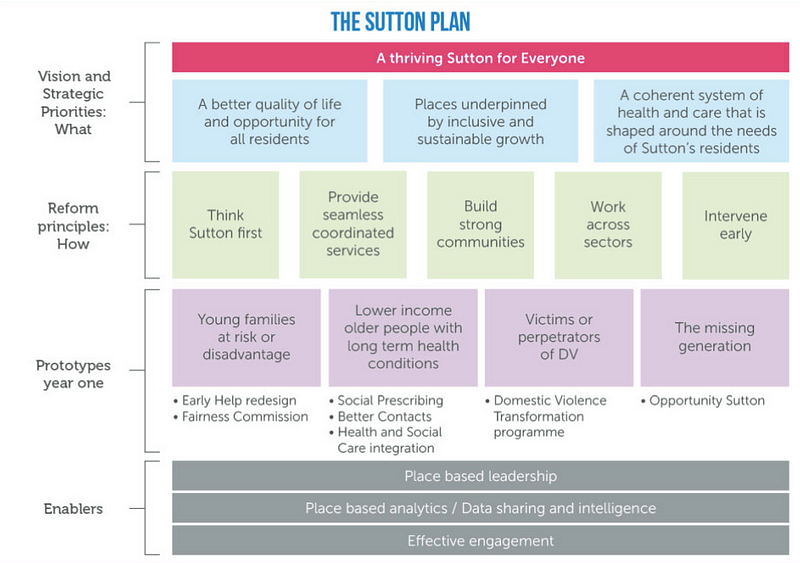Reflections on the value of a place-based plan from Hannah Anderson, Director at Collaborate CIC
17 Apr 2019 02:47 PM
For some time now Collaborate has been an advocate of the place-based plan; a collaborative statement of intent across key organisations that draws on a range of insights, and sets out an ambitious, place-specific approach to improving outcomes. And like most things that are well put together, we also believe they get better with time.
This is what we have found with The Sutton Plan.
In 2016 we began supporting the London Borough of Sutton to design a place-based plan that would be jointly created and owned by all local organisations and stakeholders. This process involved multiple valuable inputs — from pulling together a rich set of place-based data from a range of local agencies for the first time ever, through to deep and wide community engagement, as well as more focused inquiries into specific issues, such as the support provided to local parents.
But more than that, it required brave conversations. There was a lot to explore about what was working well in the borough, and what could be built on to deepen collaboration and improve outcomes. However, there were also honest conversations about where the system of support was falling short, or where there were challenges in the way organisations were working both with each other and residents (operating in silos, incentivising competition, not addressing the root issues, for example).
This overall process of inquiry which was deeply rooted in place, involved hundreds of people, a number of large-scale collaborative events, and stretched across six months. The output was the Sutton Plan, and the outcome was a renewed focus on the potential of place and the value of genuine partnership working. The Plan is more than a symbolic document or statement of intent: it has real influence in the borough (and beyond); informing the way partners work together to address complex, deep-rooted and challenging issues.

We think there are a number of key reasons why the Sutton Plan has been an effective tool for change:
1. The focus on the how: As one health partner said — “don’t underestimate the power of ‘shall we?’ rather than ‘you must’ as an energising approach”. As well as setting out a number of borough-wide strategic priorities — what partners wanted to tackle together — they also invested time in considering how they wanted to work together (and with residents). This has resulted in 5 principles that, when considered in concert, have a significant effect on the way that support offers, and services are designed and delivered in Sutton. We have noticed, that often with place-based plans, a great deal of attention is given to the what and less to the how. But in our experience, if we want organisations to work together as part of a system, then it is helpful for partners to spend time together, building trust and co-designing some core principles to underpin their approach. The work that Sutton has taken forward, following the Plan, has been deeply influenced by the principles.
2. New plan, fresh approach: This wasn’t about designing a plan and then retrofitting it to the work that already existed. The Plan highlighted some significant challenges in the borough, and with that signalled to partners, that new ways of working would need to be explored. This was about capitalising on the energy and enthusiasm from partners during the development of the Plan, and finding opportunities to test new approaches to complex challenges. Whether it has been about reviewing and improving the system of support for perinatal and infant mental health, or collaboration to tackle domestic abuse, the Plan has acted as an enabler and, at times, a signifier of permission to organisations and people to work in new ways.
The Plan has also informed and influenced other key strategies. The Sutton Health and Care Plan, for example, has evolved under the banner of the Sutton Plan. This has enabled a place-based approach to health and social care integration rather than it fitting into a pre-determined, top-down agenda.
3. Treat it as a live, evolving model: Places evolve, and local challenges and opportunities change too. Plans that fail to flex to the demands of the place will struggle to remain relevant and improve outcomes. The Sutton Plan is less of a roadmap, and more of an approach. Consequently, the conversation of ‘where to next’ has been welcomed by partners at different stages. By setting this tone it frees people to engage at different points. In early 2019, more than sixty partners from Sutton came together to celebrate what has been achieved under the Sutton Plan, learn from some of the collaborative approaches that have been developed so far, and begin to design the next ambitious programme of work for delivering better outcomes in the borough. This is a hugely encouraging sign that the culture shift that the Plan signals is alive and well, and developing into new areas of work that were not outlined in the original plan documents, but which are absolutely true to its spirit and intent.
Anyone can create a plan. But only those who are willing to invest in understanding the nuances of their place, explore the value of collaboration, and draw on the perspectives of the usual and unusual suspects can develop an effective, compelling, and sustainable place-based plan. It is these plans that drive real changes in practice and culture.
In the end, it’s about getting the right plan in place.
To find out more about Collaborate’s work, please get in touch with hannah@collaboratecic.com.
Sign up to Collaborate’s newsletter here.